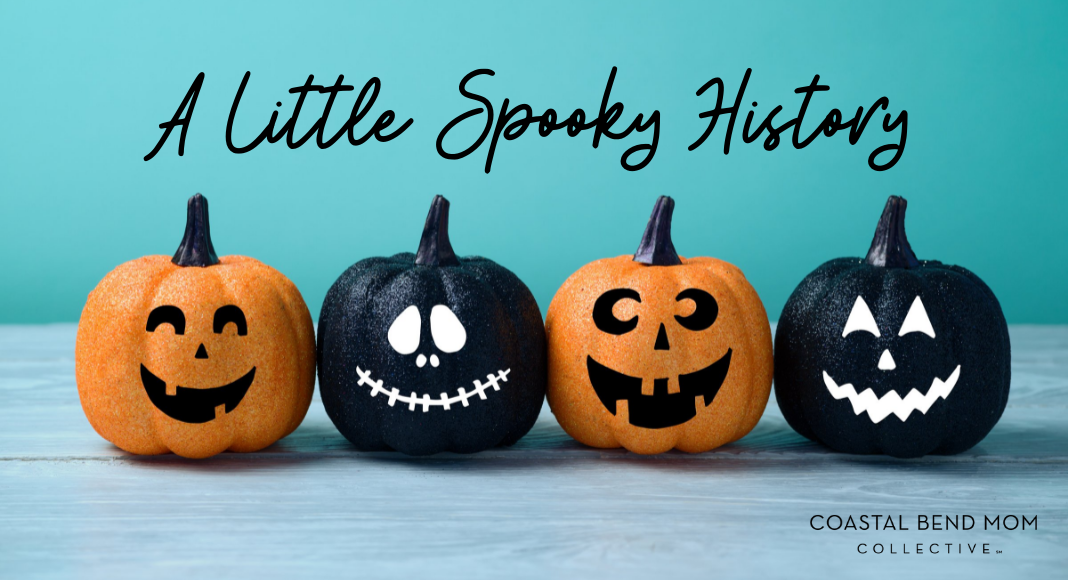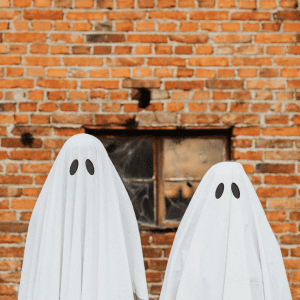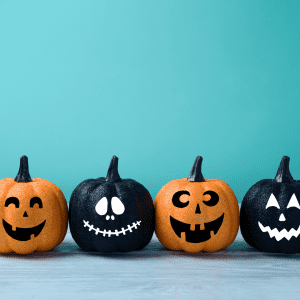Ahhhh… can you feel it? There’s a shift in the air, a creak in the doorframe, and I could swear something just flew across the moon…..it’s almost Halloween!!

If I told you I look forward to this time of year the _entire_ year, that would be underselling it considerably. I’ve hung the garland (DIY BTW), tossed out the “beware of the witch” pillows, and set the “eye of newt” (that’s just mustard seed, for what it’s worth) on the bookshelf. I am in my element, and ready to catch a cool breeze! What perfect timing to shed some light on some of the top Halloween traditions, superstitions, and origins- maybe a couple you weren’t aware of! So hang on to your heads and test your Hallo-knowledge with these!
Before we jump into the cauldron, let’s look at some history behind the actual holiday of Halloween. As much as Max Denison believed that ‘everyone here knows Halloween was invented by the candy companies, the holiday predates American confectionaries by a long shot. In fact, we can see vestiges of the holiday in multiple cultures, which isn’t that surprising, given its religious roots.
Yes, religious. Stop clutching your pearls, it’ll be ok. 😉
Western cultures (namely North America) celebrate on October 31st, the eve of the religious festival of All Hallow’s Day, a Christian tradition that spends three days honoring the dead, including saints (aka hallows), martyrs, and the dearly departed friends and family. Our South Texas families will recognize some elements of Dia de los Muertos in this.
The most widely held belief is that the holiday comes to us from Celtic harvest festivals, the Gaelic festival of Samhain to be precise. The Gaelic language being somewhat difficult, there’s a couple of ways to pronounce that: “saw-win” is a fair attempt. Samhain was the celebration of the harvest and the transition into winter, positioned as the date is halfway between the autumn equinox and the winter solstice.
Sounds pretty benign, right? Well, it was also the time of year when the Celts believed the boundary between the living and the dead was thinner (catching the All Hallow’s tones here?), and more easily crossed by the departed, but by the supernatural too. Sound like the beginning of a horror movie? Don’t worry, they had a plan…

Costumes: When you’re squaring off with the Fae, guile is the best bet. Costumes were to disguise themselves in an attempt to confuse any malevolent entities and keep themselves safe from being taken across the boundary never to return! After all, the faeries and specters are only after the living! Mass production costumes only became available in the 1930’s and were different styles of scary masks.

Jack-O-Lanterns: While very Americanized, this tradition actually comes from Ireland and the legend of Stingy Jack. Jack was an accomplished trapper and kept trapping the Devil over and over, which got a little annoying for the latter. One of these times it occurred to Stingy Jack that he should take advantage of this situation and make a deal with his hostage, a la Faust. The deal was the Devil wouldn’t take Stingy Jack to hell when he died, but Heaven apparently didn’t want his stingy self either. Caught between a rock and a hot place, Jack was doomed to roam the Earth. The Devil felt sorry enough to give Jack a hollowed-out turnip and a lump of burning coal to light his way. Let’s just say, turnips are a little horrifying. In the American colonies, pumpkins were a lot more plentiful (and easier to carve) and took the place of the carved turnips with their scary faces to ward off the evil spirits.

Black Cats: These poor guys have been getting a bad wrap since the middle ages. Initially believed to be a symbol of the Devil, it was just a hop, skip and a jump to as association as a witch’s familiar for black cats. In the US, Spain and Belgium, a black cat crossing your path means bad luck is coming your way, while in other countries it’s considered a good omen and a wish granted.

Black & Orange: Another piece of Celtic tradition here! Black was to represent the death of summer and the orange to represent the harvest season, this has ties to the Samhain festival again.

Trick-or-Treating: This is what it all seems to boil down to for my kids! When my son was 13, I asked him at what point he was going to stop trick-or-treating. He didn’t even look up from what he was doing, just replied “when they stop giving out free candy”. The tradition of trick-or-treating has actually morphed over time. Originally, it was leaving out ‘offerings’ for the passing spirits on All Hallow’s Eve. Then the Scots adapted it to a form of what they called ‘souling’ to collect food and money in exchange for prayers to benefit passed loved ones on All Souls Day. ‘Prayers’ were swapped out for ‘tricks’ for the less religiously inclined. Finally, it evolved into what we recognize from the German-American take on ‘belsnickling’. Belsnickling was a tradition where children would dress up and call on neighbors. If the adults couldn’t guess which child was which, they were rewarded with treats!
Hopefully, this new information gets you even more geared up for some safe, spooky fun this year with your friends and family, and please send us your children’s reactions if you surprise them with carved turnips, or if you trap something suspicious in your mousetrap!
If you’re looking for something to do this Spooky Season, take a look at our Coastal Bend Guide to Fall!













